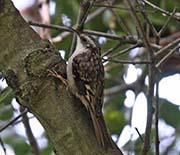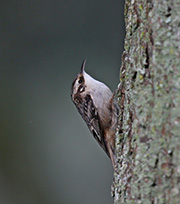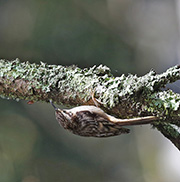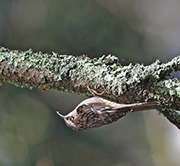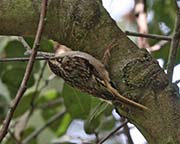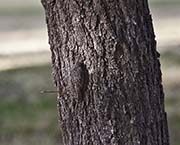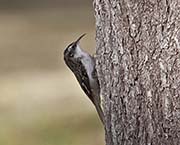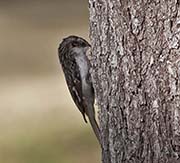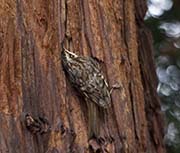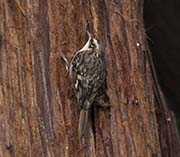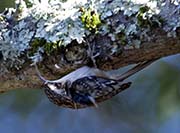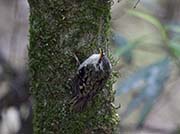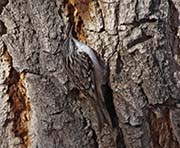Brown Creeper - Certhia americana
| Length | |
| Wingspan | |
| Weight | |
| Clutch Size | |
| Chicks at birth | |
| IUCN Conservation Status | |
Continents: |
Brown Creepers bodies are brown with off-white streaks on the upperpart and white on the underparts. Their bill is long and thin and slightly curves downward. Their tail is brown and rigid which aides them when they climb a tree. They can be hard to spot because of their small size and because their plumage blends in with tree bark. The sexes look similar but the male may be a bit larger.
Diet: Brown Creepers are fun to watch as they "walk" up a tree, frequently circling as they climb looking for spiders, beetles, larvae, insect eggs, etc. They use their thin bill to pick food from cracks and crevices. They then fly to the bottom of another tree and start climbing it. They will also sometimes eat seeds or nuts (e.g., acorns).
Courtship: Brown Creepers are believed to be monogamous. Courtship has one Creeper chasing the other around a tree trunk followed by wing-fluttering and rapid beating of wings held above the body.
Nesting: Brown Creepers usually create their nest between a tree trunk and a loose flap of bark. They also will sometimes use a knothole or abandoned woodpecker hole. The female constructs the nest from fine pieces of bark, spider-egg cases, hair, feathers, grass, lichen and moss. The male helps brings the material for the nest. The female lays 4-8 eggs and incubation appears to begin after the last egg is laid.
Habitat and Range: Brown Creeper's are found throughout North America from southern Canada into Mexico where they mainly winter. They are forest and grove dwellers and trees are critical to their survival providing both nesting locations and places to find food.
Vocalization: Song is a musical phrase of four to nine high clear notes, varying by region and from individual to individual.
Plumage/Molt: Male and females plumage is the same and they molt yearly after the breeding season (late summer or early fall).
Migration: They are considered to be a year-round resident but some may migrate south in the winter.
Tongue/feet: Legs and feet are dark brown with the claws slightly darker. The toes are anisodactyl with three toes in the front and the fourth is in the back. They have long sharp claws (the back claw is slightly longer) which aids them in climbing trees.
Bibliography:
- Harrap, Simon and David Quinn , Chickadees, Tits, Nuthatches & Treecreepers,Princeton University Press, 1995
- Sibley, David Allen, The Sibley Guide to Bird Life & Behavior,Alfred A. Knopf, New York, 2001
- http://www.birds.cornell.edu The Cornell Lab of Ornithology, Accessed June 2012
- http://en.wikipedia.org The Free Encyclopedia, Accessed June 2012
